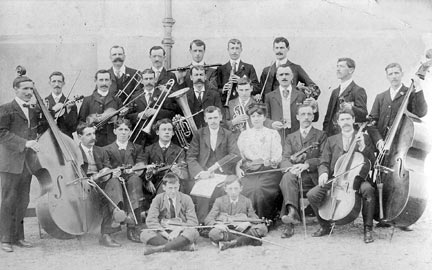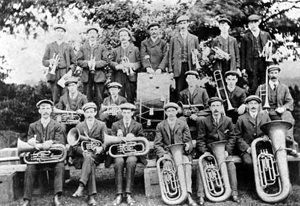Culture - Bands
Brass bands.
The brass band played a central role in the
cultural life of the community, not only in the quarrying villages,
but beyond. The band was without a doubt one of the
status symbols of the quarryman. Just by taking the area from the Carneddau to the Eifl, this is an approximation of the number of
bands in the area.
| Town/Village |
No |
Town/Village |
No |
Bethesda/Penrhyn
Caernarfon
Pwllheli
Rhiwlas
Llanberis/Faenol
Deiniolen
Brynrefail
Carmel
Dolwyddelan
Garn Dolbenmaen
Baladeulyn
Y Groeslon
Dyffryn Nantlle
Cricieth
Trefor |
2
2
1
1
1
1
1
1
1
1
1
1
1
1
1
|
Bangor
Porthmadog
Pentir
Y Felinheli
Nant Peris
Llanrug
Y Waunfawr
Rhosgadfan
Penmachno
Beddgelert
Penygroes
Nebo
Llanllyfni
Sarn Mellteyrn |
3
1
1
1
1
1
1
1
1
1
1
1
1
1
|
By 1888, brass bands were big business with around 40,000 of
them in the countries of Britain. By the 1920's, their number had
decreased to 9,500. The number decreased further to around 4,000
by 1988.
True, many of them were small in number, varying from eight to
fifteen members. But in the end, a band is a band. Wherever
there was a procession, the local band would lead the way.
We can be fairly certain that the earliest band to be formed
in the region was the Llanrug Band in 1830 and closely followed
by Deiniolen Band in around 1835. It must be remembered that
over the years bands changed their names. The Deiniolen Band, for
instance, went under the names of Llandinorwig, then Ebenezer,
then Llanbabo, and then Cynfi at various times. And then there was
the Nantlle Vale Band that started off in 1865 as the Penyrorsedd
Band.
In the slate quarrying areas, the quarry owner would usually
buy the instruments, and it was not unusual for a resident
bandmaster to be given employment by him. Indeed, by the 1890's
some of the bands in the area had been given the prefix Royal and
competed regularly at Belle Vue, Manchester, as well as other
competitions including the National Eisteddfod and the North
Wales Championships. For major competitions professional tutors
would be called in as well as a number of experienced players,
usually from England, to boost the ranks.
But it must also be remembered that the fortunes of the bands
was closely linked to the economic success of the slate
industry.
The Royal Bands
 The Penrhyn Band
became the Royal Penrhyn Band following Queen Victoria's visit to the
castle in 1862. The Penrhyn Band
became the Royal Penrhyn Band following Queen Victoria's visit to the
castle in 1862.
The Oakeley Band was invited to Bala in 1889 for Victoria's
Royal Visit. Shops in the town displayed the Royal Warrant and
the band became the Royal Oakeley for their valued service. When
the band went to compete at Llandudno that year, 1,200 supporters
came from Blaenau with them.
Belle Vue was visited for the first time in 1904. After a
famous victory at the Swansea National Eisteddfod in 1907, the Royal Oakeley
band
were hailed as the 'Champion Band of Wales.' Similar successes
were also experienced during the 1920's and 1930's. During the
1939-45 War, the band was known as the 'Home Guard Band.' Re-founded after the war much of the former success
has been
revived.
Nantlle Band was invited to play selections on board an
anchored ship for the amusement of the Prince and Princess of
Wales, during their visit to the Caernarfon National Eisteddfod in
1894, as the royals sailed gaily by on the royal yacht. That day
the Royal Nantlle Vale Band came into being.
During the Dinorwig strike of 1885-86, the Llanrug Band came to
play for the strikers. G.W.D. Assheton Smith had been their
patron since 1871. He had presented them with new uniforms,
together with busby hats, a practice room at Gilfach Ddu in the
quarry itself, as well as a new set of silver instruments worth
£400. They were also given a new name, The Royal Vaynol Silver
Band.
Bands and Strikes
But after leading a march of striking
quarrymen to 'Craig yr Undeb' (Union Rock) in 1885, they were
ordered forthwith to return their instruments to the band room at
Gilfach Ddu and to leave them there until further notice.
Marching back, they were persuaded by some of the onlookers to
play a couple of marches. They obliged, and in so doing gave
Assheton Smith the excuse to confiscate their instruments
permanently. He then took the opportunity of presenting them to
a newly formed band in Llanberis and employed a conductor and
tutor from England in 1886.
The instrument-less band was forced to
borrow a set to compete soon after, and even though they won,
they were disqualified for not using their own
instruments!
The red-letter day for the bands of course was May Day, and it
was not unusual to see as many as eight marching in the main
procession. In 1892 the festival was held at Caernarfon. Since
Lord Penrhyn and E.A.Young as we have seen did not look
favourably on any form of trade unionism, and that Penrhyn owned
all the instruments, a warning was sent out that the band was not
to use the instruments at any cost. However, the union happened
to own the bass drum. Consequently, the Royal Penrhyn Band marched
to the drumbeat alone.
Rivalry existed between many of the bands. Llan Ffestiniog
Band, founded around 1864, never became 'royal.' But between 1883
and 1895 they won prize money to the value of nearly £300.
Local brass band competitions were regular events, and Llan
Ffestiniog were very successful in competitions in Porthmadog,
Barmouth, Dolgellau, Llanrwst, Llanfairfechan, Corwen, Rhyl, Bala
and Caernarfon.
|